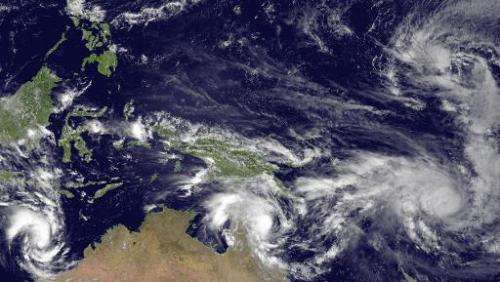Cyclone, hurricane, typhoon: different names for same violent phenomenon

They may have different names according to the region they hit, but cyclones, hurricanes and typhoons are all violent tropical storms that can generate 10 times as much energy as the Hiroshima atomic bomb.
Cyclone is the term used for a low-pressure system that strikes the South Pacific and Indian Ocean. The same type of disturbance in the Atlantic and northeast Pacific is called a hurricane while typhoon is the term used in Asia.
But meteorologists use the term "tropical cyclone" when talking generally about these immensely powerful natural phenomena, which are divided into five categories according to the maximum sustained wind force and the scale of the potential damage they can inflict.
Cyclone Pam, which slammed into Vanuatu late Friday with wind gusts of up to 320 kilometres (200 miles) an hour, wreaked widespread devastation in the South Pacific island nation.
But Pam was not the strongest storm ever to hit the South Pacific—Tropical Cyclone Zoe, which struck in 2002, was stronger with 380 kilometres an hour winds.
Cyclones are formed from simple thunderstorms at certain times of the year when the sea temperature is more than 26 degrees Celsius (79 Fahrenheit) down to a depth of 60 metres (200 feet).
Sucking up vast quantities of water, they often produce torrential rains and flooding resulting in major loss of life and property damage.
They also trigger large swells that move faster than the cyclone and are sometimes spotted up to 1,000 kilometres ahead of the powerful storm. The sea level can rise several metres.
These powerful weather formations can measure between 500 and 1,000 kilometres in diameter and have a relatively calm "eye" at the centre.
They weaken rapidly when they travel over land or colder ocean waters.
Cyclones are closely monitored by satellites, and specialised centres around the world—in Miami, Tokyo, Honolulu and New Delhi—track the super storms' trajectories under the coordination of the World Meteorological Organisation.
© 2015 AFP




















